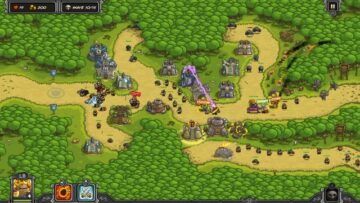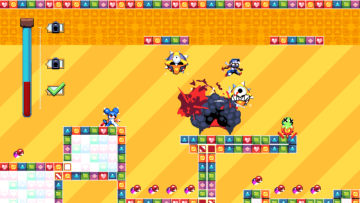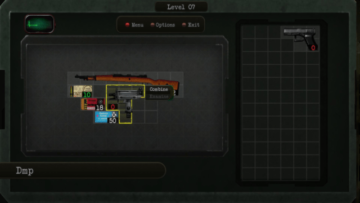Some games make us want to clamber into the game design like a mechanic and make some changes. They’re games we love, but all they need is the tiniest of tune-ups to make them immeasurably better.
Oaken is one of these games. It’s undoubtedly brilliant – a strategy board game brought to life, a fantastic setting, and an intricate, clever roguelike – but it’s covered in so many small brambles that true greatness is out of its reach. We’ve played a similar game that gave us a similar reaction, only a few weeks ago. Oaken and Dark Quest 3 share a flawed approach to bringing turn-based strategy to the roguelike. We kind of wish they got together and solved the problem together, as they both get very different things wrong.
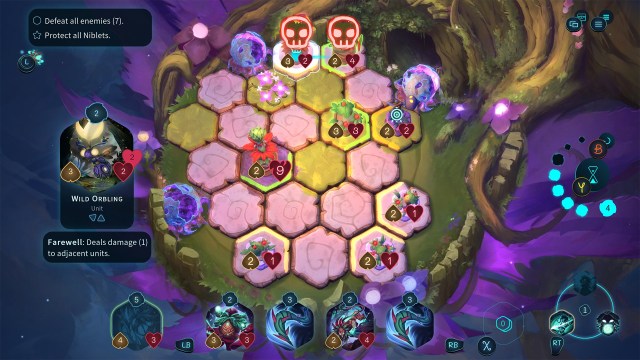

Oaken’s world is lovely. Gone are the loincloths and robes of the fantasy genre. It’s a strategy game without tanks or troops. You play plants and fungi, fighting over the forest. It gives Oaken a unique, fight-on-the-forest-floor feel, and the art style leans into the bioluminescence, thorns and spores. The character designs take advantage of the aesthetic, offering just the right amount of humanity to make them identifiable.
With Oaken, there’s always a ‘but’. At a zoomed out view in an isometric grid, it’s genuinely hard to tell which unit is what. They blur into the same bulbous mass, and all that hard work in the character design is slightly undone. Only the bigger bosses really manage to stand out. All of the units look good on the card art, though.
The pattern of play is the same every run. You choose your hero, who comes with their stock selection of abilities. Then you select a sidekick: a unit which is always available, regardless of the cards in your hand. These tend to be more expensive, powerful cards that you can rely on to turn the tide of a battle. Then it’s time to start the run.
The path you follow will be familiar to any Slay the Spire fan. You’re given a vertical set of nodes (going downwards, so maybe it is different from Slay the Spire), and you can choose your path through them. There isn’t a huge amount of wiggle room there, as you can only move slightly to the left and slightly to the right, but more often than not you have two or three choices for your next encounter.
It’s a formula that has worked on countless other games. Oaken deviates a little by allowing you to make upgrades to your units whenever you want, rather than beeline to a shop or blacksmith. That freedom is welcome, but the trade-off is that the locations are all too similar to each other. They are variations on a theme: kill everything, kill everything but with an objective attached, or kill a boss. The only exception is Events, which offer some neat trade-offs of punishments against rewards. But mostly it’s combat, and that makes the choice a little moot: everything’s going to end in some fisticuffs.
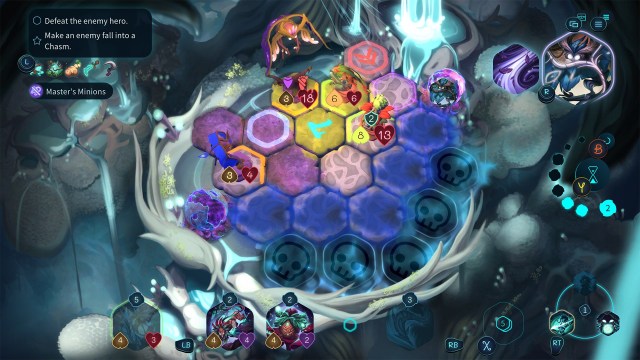

Fighting is simple but effective. Your hero starts on the hex grid, and there will be enemies there too. Those enemies have bases which pump out reinforcements, helpfully denoted by a character icon. You’ve always got an inkling of where they are going to land, as they can drop into one of a few surrounding spots.
You won’t stay alone for long. Each turn, you get a kind of mana which is spent on spawning ‘spirits’ (the game’s units), casting spells, or using one of your hero’s abilities, which are constantly available and refresh with each turn. Oaken has a deft limitation to spawning enemies, as they can only be placed within your hero’s sphere of influence, i.e. pretty damn close. That creates a neat tension that is always there: the game is over when your hero is dead, but you need your hero close to the action, so that they can dump plants and fungi into your enemies’ path. It’s potted genius.
Once your unit is down, they have a kind of summoning sickness which means they can’t attack this turn (unless they have Haste). But once they’re up and running, they can move once per turn, and attack once per turn. That attack must be in their ‘line of sight’, which is determined by the direction that they are facing. You can see that direction by three lines on the hex.
Line of sight and the orientation of each character is a pain in the arse, and no matter how much we scratched, we couldn’t get rid of it. It’s just too unnecessarily fiddly to attack a creature that’s near to you. If one is behind you, you have to pivot to face them, which uses up your movement. ‘Shooter’ units are exposed to way too many rules. They can only fire according to line of sight; the enemy can’t be more than three hexes away; and a unit can’t be next to the unit, otherwise they engage in melee, which means your shooter gets counter-attacked. And maybe it’s just us, but we kept choosing an orientation, only for the analogue stick to move a millimetre and change it to a different one.
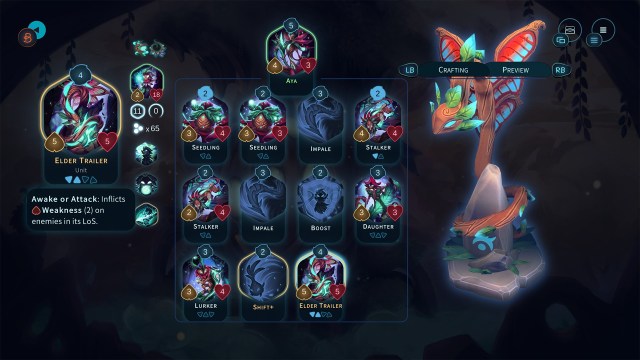

But mostly it’s a fine, strategic approach to hex-based combat. You can sneak around an enemy and hit them on the back for uncounterable damage. You can shove enemies into each other, chaining up stacks of damage. And Oaken’s speciality is littering the playfield with plants and crystals, each of which have their own effect. They might bounce you around the arena like you’re in Pinball FX, or explode in a shower of Lumi, the game’s currency. When combined with the shoving and area-of-effect skills, there’s huge potential for synergies.
Here comes the ‘but’ again. Oaken is an incredibly hard to read game. That’s less to do with the size of fonts, and more about basic legibility of what’s going on. Each enemy has its own list of effects, as do your units. The plants and mushrooms have effects, and the hex terrain does too. That’s exacerbated by almost every effect being a keyword, but you can’t – at least as far as we’ve found – expand on any given one. What you need to do is press start, tab across to a glossary and then find the relevant term. Then you hop back into the game.
This huge, wobbly ball of cognitive load and complexity doesn’t get any smaller for ten or so hours. We still haven’t remembered every keyword, and we still get in situations where – inexplicably – we do more or less damage than we expected, because something combined with something else. The designers have clearly got too close to their game: as Harrison Ford once famously said to George Lucas, “you can type this s**t, but you sure as hell can’t say it”, and we had similar feelings. What this means is that there is a lack of trust in what might happen if you do the most basic of things, like attacking or moving. An effect might trigger that we didn’t anticipate, and that lack of surety is a problem.
It’s a problem because death is so punitive. Die, and you are back to the start of the run. When a run takes – we kid you not – a good few hours, that sudden and unpredictable death stings like a dagger to the gut. There’s a ‘but’ here, and it’s a positive one this time. You CAN restart the battle once, which might be enough with your newfound knowledge, and you CAN play on a mode that allows you to play on past deaths. But even that latter option has its own punitive problems: you restart at the beginning of the chapter, which means death-by-boss takes you back ten or so battles.
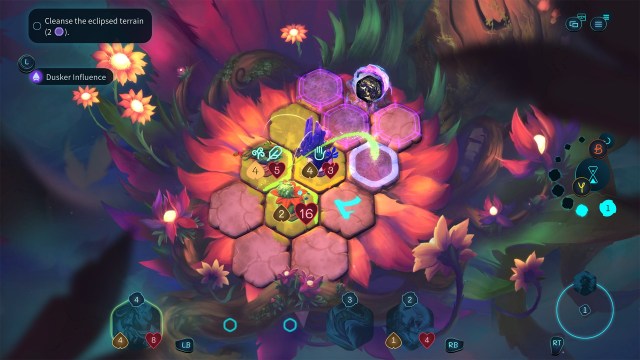

We could go on, yet we’ve gone on too long already. And that’s because we’re passionate about Oaken – we can see the game that it should be. The art is gorgeous, the ideas plentiful, and there’s so much depth to the combat and upgrades that it boggles the mind.
You can see the ‘but’ coming now: Oaken just can’t capitalise on that good work. It’s too convoluted as a turn-based strategy game, it takes too much time to assess any given situation, and restarting a run takes far too long. The ivy crawls around Oaken and drags it down, when it should be shooting up into the sky.
- SEO Powered Content & PR Distribution. Get Amplified Today.
- PlatoData.Network Vertical Generative Ai. Empower Yourself. Access Here.
- PlatoAiStream. Web3 Intelligence. Knowledge Amplified. Access Here.
- PlatoESG. Automotive / EVs, Carbon, CleanTech, Energy, Environment, Solar, Waste Management. Access Here.
- BlockOffsets. Modernizing Environmental Offset Ownership. Access Here.
- Source: https://www.thexboxhub.com/oaken-review/
- 1
- 12
- a
- abilities
- About
- according
- across
- Action
- ADvantage
- aesthetic
- again
- Against
- ago
- AI
- All
- Allowing
- allows
- alone
- already
- always
- amount
- an
- and
- anticipate
- any
- approach
- ARE
- Arena
- around
- Art
- as
- assess
- At
- available
- away
- back
- ball
- Battle
- battles
- BE
- because
- beginning
- behind
- being
- Better
- bigger
- Bit
- Blacksmith
- board
- board game
- both
- bringing
- brought
- but
- by
- CAN
- card
- Cards
- casting
- change
- changes
- chapter
- character
- choice
- choices
- choose
- Choosing
- clearly
- close
- cognitive
- combat
- combined
- comes
- coming
- complexity
- constantly
- content
- could
- covered
- creates
- Currency
- Dagger
- damage
- dead
- death
- depth
- Design
- designers
- designs
- different
- direction
- do
- does
- down
- Drop
- e
- each
- Effect
- Effective
- effects
- else
- end
- engage
- enough
- Enter
- even
- events
- Every
- everything
- exception
- Expand
- expected
- expensive
- Face
- facing
- familiar
- famously
- fan
- FANTASY
- far
- feel
- feelings
- few
- Fighting
- find
- fine
- Fire
- flawed
- follow
- For
- Ford
- formula
- Freedom
- from
- fungi
- game
- Games
- Genre
- George
- Get
- given
- gives
- go
- going
- Gold
- gone
- good
- Grid
- had
- hand
- Hard
- hard work
- has
- Have
- here
- Hero
- HIT
- hours
- How
- HTTPS
- huge
- Humanity
- i
- ICON
- ideas
- if
- in
- influence
- into
- Is
- IT
- ITS
- jpg
- just
- kept
- kind
- knowledge
- lack
- Land
- least
- left
- less
- Life
- like
- Line
- lines
- List
- Little
- Live
- load
- locations
- Long
- Look
- love
- make
- MAKES
- manage
- many
- mass
- matter
- maybe
- means
- Melee
- might
- mind
- mode
- Month
- more
- most
- mostly
- move
- movement
- moving
- much
- must
- Near
- Neat
- need
- Next
- no
- nodes
- not
- now
- objective
- of
- offer
- offering
- often
- on
- once
- One
- only
- Option
- or
- Other
- otherwise
- out
- over
- own
- Pain
- passionate
- Past
- path
- Pattern
- per
- Pivot
- plants
- plato
- plato data intelligence
- platodata
- platogaming
- play
- played
- Positive
- potential
- powerful
- press
- pretty
- Problem
- problems
- pump
- quest
- rather
- reach
- reaction
- read
- really
- regardless
- relevant
- rely
- review
- Rewards
- right
- Roguelike
- room
- rules
- Run
- running
- Said
- same
- say
- see
- selection
- set
- setting
- Share
- Shooter
- shooting
- Shop
- should
- sight
- similar
- Simple
- situation
- situations
- Size
- skills
- sky
- small
- smaller
- sneak
- So
- some
- something
- stand
- start
- stay
- stock
- Strategic
- strategic approach
- Strategy
- strategy game
- style
- subscription
- sudden
- sure
- surrounding
- TAB
- Take
- takes
- tell
- ten
- term
- than
- that
- The
- The Game
- their
- Them
- theme
- then
- there
- These
- they
- things
- this
- those
- though
- three
- Through
- Tide
- time
- to
- together
- too
- trigger
- true
- Trust
- turn
- two
- type
- undoubtedly
- unique
- unit
- unnecessarily
- unpredictable
- up
- upgrades
- us
- uses
- using
- vertical
- very
- View
- want
- way
- we
- weeks
- welcome
- What
- when
- whenever
- where
- WHO
- will
- win
- with
- within
- without
- Work
- worked
- works
- world
- wrong
- xbox
- Xbox Live
- Xbox Live Gold
- yet
- you
- your
- zephyrnet


